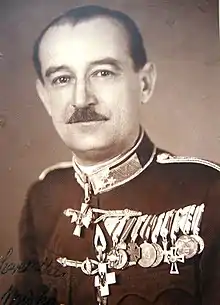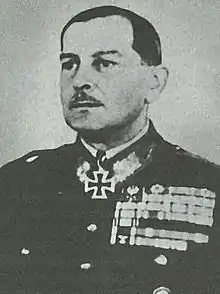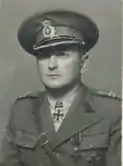In total, 43 individuals in the military of allies of Nazi Germany were awarded the Knight's Cross of the Iron Cross (German: Ritterkreuz des Eisernen Kreuzes), the highest award in the military of Nazi Germany during World War II. Eight of these men were also honoured with the next higher grade, the Oak Leaves to the Knight's Cross, and one senior naval officer, Fleet Admiral Isoroku Yamamoto, was additionally awarded the Swords to the Knight's Cross with Oak Leaves. Among the recipients were eighteen Romanians, nine Italians, eight Hungarians, two Slovaks, two Japanese, two Spaniards, two Finns, one Dutch man, and one Belgian.[Note 1]
Colonel General Dezső László of Hungary became the last foreign recipient of the award on 3 March 1945. The last surviving foreign recipient of the award was Belgian politician Léon Degrelle, who died on 31 March 1994, fifty years after receiving the medal from Hitler's hands.
Background
The Oberkommando der Wehrmacht kept separate Knight's Cross lists, one for each of the military branches, Heer (Army), Kriegsmarine (Navy), Luftwaffe (Air force) and for the Waffen-SS. Within each of these lists a unique sequential number was assigned to each recipient. The same numbering paradigm was applied to the higher grades of the Knight's Cross, one list per grade. Once the four lists of the Knight's Cross recipients were merged into one listing, the chronological order was abandoned and the list was converted to an alphabetical list of recipients. Foreign recipients were never integrated into this list. The Wehrmacht also refrained from assigning a numbering scheme to the different lists of foreign recipients. Two principles were retained: the foreign Knights Cross recipients were ordered alphabetically and the recipients of the higher grades were ordered chronologically.[2]
The Knight's Cross of the Iron Cross and its higher grades were based on four separate enactments. The first enactment Reichsgesetzblatt I S. 1573 of 1 September 1939 instituted the Iron Cross (Eisernes Kreuz) and the Knight's Cross of the Iron Cross.[3] As the war progressed, some of the recipients distinguished themselves further and a higher grade, the Oak Leaves to Knight's Cross of the Iron Cross, was instituted. The Oak Leaves, as they were commonly referred to, were based on the enactment Reichsgesetzblatt I S. 849 of 3 June 1940.[4] In 1941, two higher grades of the Knight's Cross were instituted. The enactment Reichsgesetzblatt I S. 613 of 28 September 1941 introduced the Knight's Cross of the Iron Cross with Oak Leaves and Swords and the Knight's Cross of the Iron Cross with Oak Leaves, Swords and Diamonds.[5] At the end of 1944 the final grade, the Knight's Cross of the Iron Cross with Golden Oak Leaves, Swords, and Diamonds (Ritterkreuz des Eisernen Kreuzes mit goldenem Eichenlaub, Schwertern und Brillanten), based on the enactment Reichsgesetzblatt 1945 I S. 11 of 29 December 1944, concluded the variants of the Knight's Cross.[6]
Recipients
The recipients of the Knight's Cross of the Iron Cross are initially ordered alphabetically whereas the recipients of the higher grades are initially ordered chronologically. The rank listed is the recipient's rank at the time the Knight's Cross or the Oak Leaves were awarded.
This along with the * (asterisk), indicates that the Knight's Cross was awarded posthumously.
Recipients of the Knight's Cross of the Iron Cross with Oak Leaves and Swords
The Knight's Cross with Oak Leaves and Swords is based on the enactment Reichsgesetzblatt I S. 613 of 28 September 1941 to reward those servicemen who had already been awarded the Oak Leaves to the Knight's Cross of the Iron Cross. Isoroku Yamamoto was the sole non-German combatant to be honoured with the Swords to the Knight's Cross with Oak Leaves.
| Name | Country | Rank | Unit | Date of award | Notes | Picture |
|---|---|---|---|---|---|---|
| Isoroku Yamamoto | Japan | Fleet Admiral | Commander-in-chief of the IJN Combined Fleet | 27 May 1943* | Killed in action 18 April 1943[7] | 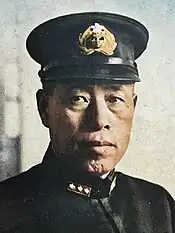 |
Recipients of the Knight's Cross of the Iron Cross with Oak Leaves
The Knight's Cross with Oak Leaves was based on the enactment Reichsgesetzblatt I S. 849 of 3 June 1940.
| Name | Country | Rank | Unit | Date of award | Notes | Picture |
|---|---|---|---|---|---|---|
| Mihail Lascăr | Romania | Major General (General de divizie)[8] | 6th Infantry Division of the 3rd Romanian Army | 22 November 1942 | — |  |
| Agustín Muñoz Grandes | Spain | Lieutenant General | Blue Division (250. Infantry Division) | 13 December 1942 | — | .jpg.webp) |
| Isoroku Yamamoto | Japan | Fleet Admiral | Commander-in-chief of the IJN Combined Fleet | 27 May 1943* | Awarded Swords 27 May 1943 |  |
| Corneliu Teodorini | Romania | Brigadier General (General de brigadă)[9] | 6th Cavalry Division | 8 December 1943 | — |  |
| Petre Dumitrescu | Romania | Lieutenant General (General de armată)[10] | 3rd Romanian Army | 4 April 1944 | — |  |
| Mineichi Koga | Japan | Fleet Admiral | Japanese Chief of Fleet | 12 May 1944* | Killed in action 31 March 1944[11] |  |
| Carl Gustaf Emil Mannerheim | Finland | Marshal of Finland | President and Commander-in-chief of Finnish Defense Forces | 5 August 1944 | — |  |
| Léon Degrelle | Belgium | Major (SS-Sturmbannführer) | 5. SS-Freiw.-Sturm-Brig. "Wallonien" | 27 August 1944 | — | 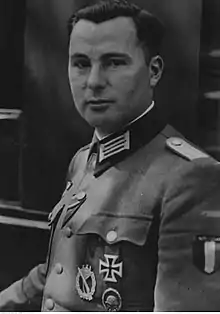 |
Recipients of the Knight's Cross of the Iron Cross
The Knight's Cross of the Iron Cross is based on the enactment Reichsgesetzblatt I S. 1573 of 1 September 1939 Verordnung über die Erneuerung des Eisernen Kreuzes (Regulation of the renewing of the Iron Cross).
Notes
- ↑ Léon Degrelle from Belgium had received the Knight's Cross of the Iron Cross while subordinated to the Wehrmacht. Degrelle had received the Knight's Cross as SS-Hauptsturmführer der Reserve and leader of the 5. SS-Freiwilligen-Brigade "Wallonien" on 20 February 1944.[1]
- ↑ According to Scherzer on 28 April 1944.[15]
References
Citations
- ↑ Scherzer 2007, p. 268.
- ↑ Fellgiebel 2000, p. 112.
- ↑ "Reichsgesetzblatt Teil I S. 1573; 1 September 1939" (PDF). ALEX Österreichische Nationalbibliothek (in German). Reichsministerium des Inneren (Ministry of the Interior). Retrieved 21 February 2008.
- ↑ "Reichsgesetzblatt Teil I S. 849; 3 June 1940" (PDF). ALEX Österreichische Nationalbibliothek (in German). Reichsministerium des Inneren (Ministry of the Interior). Retrieved 21 February 2008.
- ↑ "Reichsgesetzblatt Teil I S. 613; 28 September 1941" (PDF). ALEX Österreichische Nationalbibliothek (in German). Reichsministerium des Inneren (Ministry of the Interior). Retrieved 21 February 2008.
- ↑ "Reichsgesetzblatt 1945 I S. 11; 29 December 1944" (PDF). ALEX Österreichische Nationalbibliothek (in German). Reichsministerium des Inneren (Ministry of the Interior). Retrieved 21 February 2008.
- ↑ Scherzer 2007, p. 801.
- 1 2 Scherzer 2007, p. 495.
- ↑ Scherzer 2007, p. 739.
- 1 2 Scherzer 2007, p. 284.
- ↑ Scherzer 2007, p. 462.
- ↑ Scherzer 2007, p. 257.
- ↑ Scherzer 2007, p. 328.
- ↑ Scherzer 2007, p. 332.
- ↑ Scherzer 2007, p. 413.
- ↑ Scherzer 2007, p. 528.
Bibliography
- Fellgiebel, Walther-Peer (2000) [1986]. Die Träger des Ritterkreuzes des Eisernen Kreuzes 1939–1945 — Die Inhaber der höchsten Auszeichnung des Zweiten Weltkrieges aller Wehrmachtteile [The Bearers of the Knight's Cross of the Iron Cross 1939–1945 — The Owners of the Highest Award of the Second World War of all Wehrmacht Branches] (in German). Friedberg, Germany: Podzun-Pallas. ISBN 978-3-7909-0284-6.
- Scherzer, Veit (2007). Die Ritterkreuzträger 1939–1945 Die Inhaber des Ritterkreuzes des Eisernen Kreuzes 1939 von Heer, Luftwaffe, Kriegsmarine, Waffen-SS, Volkssturm sowie mit Deutschland verbündeter Streitkräfte nach den Unterlagen des Bundesarchives [The Knight's Cross Bearers 1939–1945 The Holders of the Knight's Cross of the Iron Cross 1939 by Army, Air Force, Navy, Waffen-SS, Volkssturm and Allied Forces with Germany According to the Documents of the Federal Archives] (in German). Jena, Germany: Scherzers Miltaer-Verlag. ISBN 978-3-938845-17-2.
External links
- "Die Träger des Ritterkreuzes". Lexikon der Wehrmacht (in German). Retrieved 2 January 2011.
- "Das Bundesarchiv". Military Archive - Freiburg im Breisgau. Archived from the original on 29 December 2010. Retrieved 2 January 2011.
.jpg.webp)

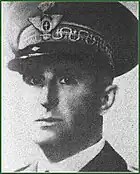






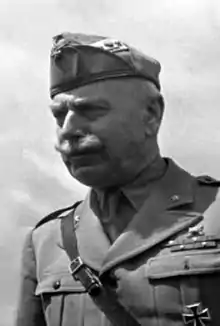

.jpg.webp)
.jpg.webp)

_(cropped).jpg.webp)

